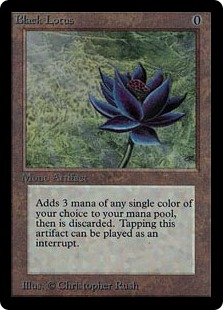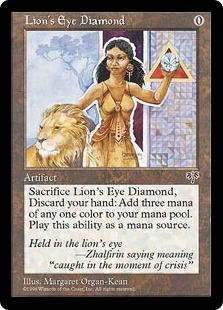Introduction
You Make the Card 4 arrived with much fanfare and even greater surprise. It has been seven years since the last You Make the Card (YMTC) campaign. Its return coincides with the 20th anniversary of Magic, and is a celebratory gesture by Wizards of the Coast on the game’s behalf.
Perhaps as surprising as YMTC’s welcome but unexpected return are the voting results so far. In the card type vote, Land and Enchantment received the most votes, with Enchantment winning a tight run-off. Not only was this result unexpected (few people thought Enchantment would be a top vote-getter), but it was surprising for what it signifies. I believe that these results may be interpreted, as others have suggested, as a signal to collectively push this process in a different direction than previous YMTC events, in which voters selected Creature, Artifact, and Instant as the card types.
While it may be natural, given the lackluster outcomes for at least two of those processes, to wish to see a different card type than had been developed before, what makes this so surprising is the length of time between those previous campaigns and the current one. Given the rapid and explosive growth of the game in the last decade, I would hazard to guess that less than half of participants now engaged in the current YMTC process were involved in previous voting. Why, then, would people who no direct experience with the previous YMTC experience now enact the collective preferences of a community that had that experience?
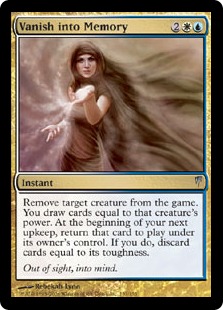 Perhaps the simple answer is the fact that small vote margins are decisive in a process like this. It only takes a few percentage points to garner a plurality vote in a 5-way race, as the ‘card type’ vote demonstrated. Previous participants may be swaying vote totals. But I also suspect that even players who didn’t participate in the previous YMTC voting processes internalized a desire to avoid a similar result in view of the disappointing outcomes of the aptly named Forgotten Ancient and Vanish into Memory.
Perhaps the simple answer is the fact that small vote margins are decisive in a process like this. It only takes a few percentage points to garner a plurality vote in a 5-way race, as the ‘card type’ vote demonstrated. Previous participants may be swaying vote totals. But I also suspect that even players who didn’t participate in the previous YMTC voting processes internalized a desire to avoid a similar result in view of the disappointing outcomes of the aptly named Forgotten Ancient and Vanish into Memory.
As of this writing, the Magic community has selected black enchantment for the YMTC 4, and has been asked to submit rules text for this enchantment. In this article, I explore what YMTC may mean for Eternal formats, attempt to resolve some tensions in designing cards for Eternal, suggest why design matters for Eternal, set out a framework for designing cards for Eternal, suggest three especially fruitful approaches to designing for Eternal, and apply those principles to possible card submissions for this YMTC process. While YMTC offers a ready context for these ideas, the design approaches and frameworks I explore are applicable far beyond this narrow, but exciting, process.
Should We Design for Eternal?
There are very few opportunities for Magic players or the Magic community to contribute to card design. Aside from YMTC, the only other opportunity for players outside of Wizards to do so is the now defunct Magic Invitational, in which winners were invited to submit a card of their choice to Wizards R&D.
Since YMTC is a rare opportunity to influence the design of a Magic card, this process is of particular interest to Eternal players. In view of some players, it may be an opportunity to help create an Eternal playable. However, there are two frequently raised objections to this view.
One objection is that since Eternal players constitute such a small part of the overall Magic community, we cannot significantly influence the design process. I disagree. The vote margins in each step are as thin as the 2000 Gore/Bush recount in Florida, sans hanging chads. For example, the vote difference in the card type step was less than 2% between Land and Enchantment. It may take as little as a 1-2 percentage difference in many major steps to select a winner. If properly mobilized, even a portion of the Eternal community may well hold the decisive vote difference.
A second, more serious, objection is prudential: should Eternal players influence the YMTC process? Eternal formats are characterized by a slow, steady metagame evolution. As my History of Vintage series illustrates, only a few relevant cards enter that format’s relevant card pool with each new expansion set. This results in roughly only a dozen or so new relevant cards every year, if that. As a consequence, the core strategies in Eternal rarely change, and then only change slowly when compared to the metagame cycles of other formats.
The Schools of Magic that came into existence in the 1993-97 period continue unabated today. The changes in the format largely reflect improved tactics and tools through new printings, while preserving the same core functionality. Jace, the Mind Sculptor is a better Jayemdae Tome, Nether Void and Dark Ritual have been replaced by Sphere of Resistance effects and Mishra’s Workshop, Tendrils of Agony is a better Fireball, Blightsteel Colossus a better Serra Angel/Morphling, and so on.
This is part of the allure of Eternal. Adult Magic players with families and busy professional lives need not invest heavily in new sets to remain current, nor continually acclimate themselves to an ever changing card pool. Experienced Eternal players can return to the format after long hiatus and perform at a high level.
For the most part, cards enter the Eternal card pool as a collateral consequence of design for other formats. When new cards are designed for Eternal, we observe historical disjunctures. Printings designed to see Eternal play are not simply likely to see Eternal play, they are likely to transform or significantly change the metagame. Two cards that Wizards acknowledged were designed for Type I/Vintage are Chalice of the Void and Lodestone Golem. The results, although well known, are not universally applauded.
Designing cards for Eternal is not necessarily desirable. At a minimum, designing cards for Eternal risks disrupting the slow, natural evolution of these formats. At worst, it risks unbalancing them with unfair or metagame disturbing cards.
Although I do not have a completely persuasive answer to this objection, the YMTC process seems like a low risk opportunity for Eternal. It is not as if we are designing a set for Eternal. Just one card will emerge out of this process. Given the dearth of opportunities to design cards for Eternal, the risks are worth seeing what can be forged from this process.
Designing for Eternal
Like most Magic players, I’ve cared little about the design side of the game of Magic. I’m not the kind of player who fantasizes about creating my own set or brainstorms card ideas for Magic forums. Like most Spikes, nearly all of my mental energy in Magic is focused on winning tournaments – preparing for them, performing in them, and deconstructing/analyzing my performance after them. Design is about as interesting to me as flavor text or card art. It did not seem relevant my Magic experience. That’s why I have never written about this topic before.
I first considered Magic design was when I was invited to play at the Magic Invitational. But rather than use that at as an opportunity to think about design in a deep way, I invited the community and teammates to submit card designs for me to consider and ultimately select for my submission. I did not employ any systematic framework of design principles. Rather, I submitted a card that I thought looked interesting. The YMTC process is not just another opportunity to submit a card, but also brought to my attention more reasons to care about design, beyond the possibility of pushing for an Eternal playable.
I believe that Magic has unlimited design space. To tap that full unlimited potential, however, requires additions to the game (such as new zones, effects, or card types) that do not yet exist and may be unwise to create in the near future. Without tapping Magic’s full design potential, it is still possible to tap into virtually unlimited design space without creating any new zones, new card types, or new turn phases (or pre-game phases or pre-game effects like Serum Powder or Leylines/Gemstone Caverns cards). And, for the vast majority of purposes, and perhaps the rest of our lives, that’s really all we need. It is this latter space, rather than the full limitless range, I will now discuss.
Let me point out the obvious in order to lay the foundation. There are a limited number of zones in Magic: hand, graveyard, library, battlefield, exiled zone, and the stack. Second, there are a limited number of card types in Magic (Instant, Sorcery, etc). Third, there are a limited number of phases per turn. Fourth, and although the list is much longer, you can catalogue a basic list of simple effects in Magic (like drawing cards, dealing direct damage, discard, creature boost, etc).
If you interface these three four features of the game, you can create a virtually unlimited amount of design space. Just as a DNA strand is composed of four base elements, and give rise to virtually infinite variety of human beings, these four base features can create virtually unlimited design options in Magic. It is this conceptual framework that informs the rest of my analysis.
In one sense, designing useful cards for Eternal that are not overpowered in non-Eternal formats is a simple matter. Working backwards from the existing metagame and card pool, one can easily design cards to combat or interfere with popular strategies and tactics. In a format with lots of Moxen, it is easy to envision a Gorilla Shaman or Chalice of the Void, two cards that were designed for Type I. Grafdigger’s Cage, while not designed specifically for Vintage, also illustrates this principle: it hoses four of the most popular strategies in the format: Tinker, Yawgmoth’s Will, Oath of Druids, and Dredge tactics.
Another simple way to design Eternal playables is to look at marginally playable Vintage or Legacy cards, and then create cards that are, while not necessarily strictly superior, better overall. Many cards in Magic have a lineage or an ancestral history. Giant Growth was the first effect like that, but it has spawned literally dozens of variants since, from Bounty of the Hunt to Predator Strike. The same is increasingly true of cards like Lightning Bolt. It is possible to trace the evolution of these design ideas over time.
Greed, an unplayable rare of Legends, is clearly the design space inspiration for Necropotence.
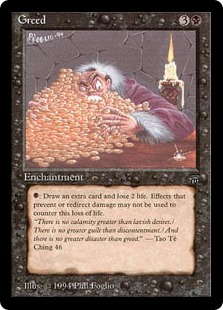
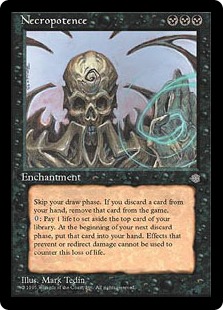
The principle of exchanging life for cards was implicit in Alpha with Lich, but became more explicit with Greed in Legends. Necropotence was a marked refinement, although much better, variant of this idea.
Improving upon marginal or otherwise playable Eternal cards as an easy way to create new playables. Nature’s Claim is a good example of this. Naturalize already saw Vintage play. Printing Nature’s Claim, a similar effect at half the cost, virtually guaranteed that it would see play. Spell Pierce, being a Misclaculation/[/card]Mana Leak[/card] variant, is a similar case.
Perhaps the most famous modern example of this is:
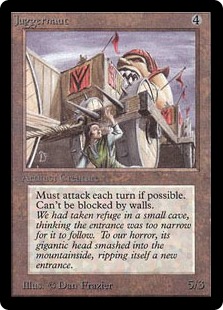
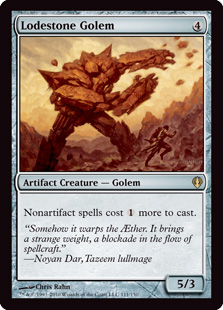
Another obvious example is Lodestone Golem, which quite literally fuses the idea of a Thorn of Amethyst-effect and Juggernaut. Both Thorn and Juggernaut were Vintage playable. Lodestone Golem is even more so, and is one of the best cards in the Vintage format.
Sometimes, in the case of very powerful cards, it is possible to make markedly weaker versions which still see play.
There have been, over the years, many, many attempts to create ‘fixed’ versions of older cards, that while not reaching the powerful level of the ancestor card, have nonetheless created a Vintage playable.
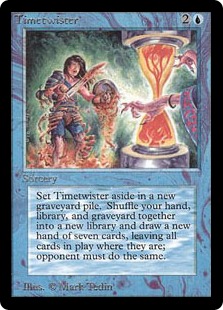
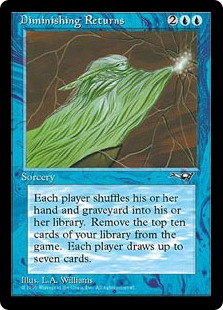
Diminishing Returns was an early and aggressive attempt to create a fixed Timetwister. While Diminishing Returns is not heavily played, it is an Eternal playable, being used in the sideboard of Burning Tendrils in Vintage and The Epic Storm in Legacy.
This kind of reverse engineering – of creating improved versions of pre-existing cards or by designing cards that disrupt popular strategies and tactics – is a very successful way to create new Eternal playables, but I’m not convinced that those are the best ways. They risk being too successful in the sense of creating playables with a high degree of confidence without expanding the strategic or tactical depth of Eternal formats.
The first method creates playables by attacking existing strategies. This can help balance problematic strategies, but it doesn’t necessarily create strategic depth. It simply provides more tools for combating existing strategies without necessarily opening up metagame space for new ones. Similarly, the second method does not necessarily expand the card pool. It more likely replaces existing cards with new ones by pushing out older ones. Granted, each of these approaches has the potential to expand the relevant Eternal card pool or create strategic depth by weakening some strategies, but I don’t think these two methods are the most fruitful ways to achieve these goals. Instead, I will suggest three alternative approaches that I believe are a rich, generative vein for Eternal card design.
1) Situationally Better & Worse Variants of Eternal Playables
This is a very intuitive design area, but only because it is a distinct, but logical extension of the idea of making improved version of existing playables. As described above, the idea of designing variants of pre-existing cards is a tradition as old as the game itself. When a new printing takes a previously unplayable or unplayed card, and makes it playable by improvement, then it potentially expands the relevant card pool. This was the case with Greed and Necropotence. However, when creating a better version of already playable cards, like Nature’s Claim/Naturalize, you risk simply replacing the older card with the better card. Since Lodestone was printed, Juggernaut has all but disappeared in the format.
I think perhaps one of the best ways to design new cards for Eternal is to take playable cards and to design variants that better and worse than the pre-existing card in equal parts. In other words, if you can create a variant of a card that is better 50% of the time and worse 50% of the time, you will have made a very interesting card.
The goal for designers should be to expand the relevant card pool. Creating variants of cards that are often better and often worse than pre-existing cards is perhaps one of the best calculated ways to do this. You are virtually assured to create an Eternal playable while increasing the total playable card pool.
Compare these, for instance:
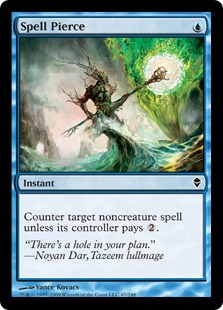
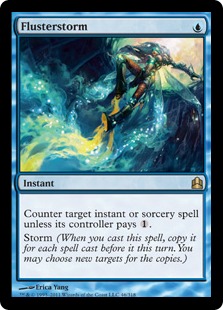
Both cards are one mana counterspells. Flusterstorm is narrower than Spell Pierce, but often situationally more powerful. It has the potential to counter storm spells, create card advantage, and be virtually uncounterable. That makes it both better and worse than Spell Pierce. Both cards see play in both Vintage and Legacy.
Compare:
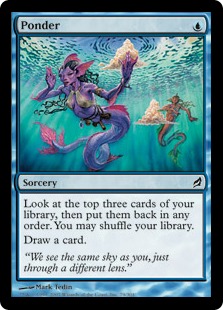
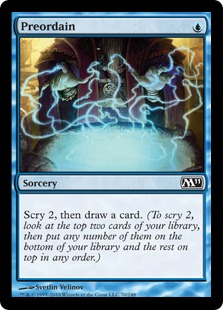
While Ancestral Recall was the original design model for this kind of card, Brainstorm, too, proved overly powered in Eternal formats, while not being necessarily strictly inferior to Ancestral Recall. Subsequently, we have seen many variants on this idea: Sleight of Hand, Portent, Ponder, Preordain, etc. The important point is that with latter printings, like Ponder and Preordain, each is situationally better than the other, with adherents arguing for the merits of each. Preordain is sometimes preferred over Ponder in decks that rely more on search, singletons and focused library manipulation. While, on the other hand, Ponder is preferred for its gross digging capacity, and ability to facilitate deep searching. Ponder may be preferred by combo decks like Preordain may be preferred by control decks.
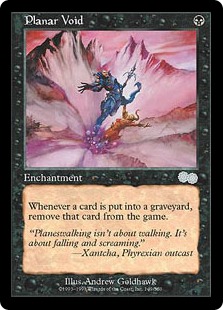
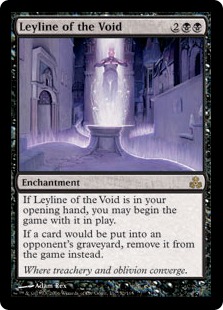
Planar Void was printed in 1998, but the design space that effect carved was essential to Leyline of the Void eight years later, which is not only one of the most important cards in Vintage, but consistently among the top 10 most played cards in the format. Leyline of the Void is a marginal improvement not just because its free – and therefore shaves off one mana cost, but it also does not affect your graveyard.
Tormod’s Crypt variants are very popular in Eternal, so likewise, compare Tormod’s Crypt, Relic of Progenitus, and Nihil Spellbomb.
All of these cards see Eternal play, but having the option to play one or the other depending on the deck is exactly what magic players want to see.
2) Extreme or Unique Conditionality
A second and very rich design space for creating Eternal cards is to create highly efficient effects based on extremely or unusual conditions. To illustrate the range of possibilities, consider the forms of conditionality that already exist on Eternal playable cards:
- Library of Alexandria and Infernal Tutor checks to see the number of cards in your hand (7 and respectively).
- Mental Misstep and Spell Snare check the casting cost of a spell they target.
- Mindbreak Trap checks to see how many cards have been played this turn.
- Mirror Universe checks the phase of the turn, and can only be activated in your upkeep.
- Serra Avenger checks to see what turn of the game it is.
- Chalice of Life checks your life total.
- Laboratory Maniac and Shelldock Isle check the number of cards in your library.
- Leylines checks to see if it is in your opening hand.
- Gemstone Caverns checks to see if they are in your opening hand and if you are not on the play.
The possibilities for design are almost infinite because of the range of conditions that can be created for spells to be cast or effects to be triggered. This list is merely illustrates examples of conditions that already exist. You could have conditions for number of cards in a zone or particular types of cards in a zone. You could have triggers for damage dealt, discard, permanents returned to hand, and on and on.
To put these ideas in perspective, consider two blue counterspells that have simple forms of conditionality.
CounterPower
0
Instant
Counter target spell. Cast CounterPower only during your upkeep.
While potentially a dangerous card, narrow cards with powerful effects pose fascinating risk/reward questions in Vintage and Legacy that are worth offering. They are not just situationally better or worse than other cards depending on myriad other factors, but the extreme conditionality invites players to find ways to abuse them without making them universally better than existing cards. That kind of conditionally expands the card pool without pushing other cards out.
One possibility that could be potentially quite useful for Eternal is to create the opposite of Serra Avenger, and to create a condition that a spell can only be played in the first three turns of the game. Here’s an example of this idea:
Artifact Stop
1U
Instant
Counter Target Artifact Spell. If you cast this spell in the first three turns of the game, you may play it without paying its mana cost.
The kinds of conditionality you can create are unlimited. The more extreme the conditionality, the more efficient/powerful the effect can be. Laboratory Maniac features one of the best possible triggers in the game: a way to win the game. However, it requires very difficult condition to satisfy, but one that can be achieved in Eternal formats. That makes Laboratory Maniac a powerful tool for Eternal.
In addition to difficult or extreme conditions, you can design cards with multiple conditions. The more conditions you require, the more powerful the effect can be. Without reaching Coalition Victory type levels, you could have cards that have two or more conditions. Multiple conditionality, for example, could require that a card be played only if you control a Swamp, have a creature in play, and have played at least three other spells this turn. Or, it could require that the opponent is at 10 or less life, you exile two spells (from the stack)*, and sacrifice a creature.
But you can interface totally unrelated forms of conditionality for very powerful effects. There are a few cards in the game that check this, but imagine a conditionality that looks at the number of cards in your library and your life total. There are plenty of cards that have a different effect depending on how low (or high) your life is, but what about combining these kinds of conditions in unique and unprecedented ways? You could have a card that can only be cast if you have 20 or less cards in your library, 5 or fewer permanents, 2 or less storm when cast, and 10 or less life, to make an extreme, but illustrative, example.
I believe that extreme conditionality is a rich resource for Eternal playability, as cards like Mindbreak Trap and Laboratory Manic illustrate. I think, however, it is high time for a card like Artifact Stop, which requires a reverse Serra Avenger conditionality, and more cards with extremely conditionality but powerful effects, like Maniac or CounterPower.
3) Unusual Alternative Costs
 Force of Will and the ‘pitch card’ cycle from Alliances was brilliant and novel because it was the first time you could use a different resource to move a card across a very important zone boundary – from the hand to the stack. Before, you had always needed mana (unless a card cost 0 mana). Using a different resource to cast spells opened up a broad new swath of design options which Wizards has never stopped mining. Spinning Darkness built upon that design space, but in a different way. You use graveyard resources to move a card from your hand to the stack, rather than removing cards from your hand – but it was Force of Will that opened the key design space that Spinning Darkness grew out of.
Force of Will and the ‘pitch card’ cycle from Alliances was brilliant and novel because it was the first time you could use a different resource to move a card across a very important zone boundary – from the hand to the stack. Before, you had always needed mana (unless a card cost 0 mana). Using a different resource to cast spells opened up a broad new swath of design options which Wizards has never stopped mining. Spinning Darkness built upon that design space, but in a different way. You use graveyard resources to move a card from your hand to the stack, rather than removing cards from your hand – but it was Force of Will that opened the key design space that Spinning Darkness grew out of.
Given what I have said in this article, two underexplored resources for alternative costs to casting spells are to remove cards from the stack or from the library to move cards from the hand to the stack. For example, I offer these two cards:
Ancestral Darkness
UB
Sorcery
As an additional cost to cast Ancestral Darkness, exile the top 20 cards of your library.
Draw three cards and lose 3 life.
Just as Force of Will and Spinning Darkness allow you to expend other resources to move a card from one zone to another (the hand to the stack), the idea of exiling a huge and very costly amount of cards from your library is yet another resource you could draw upon to facilitate that. A simpler version might simply read: Exile the top 30 cards of your library. Ancestral Knowledge is a card that taps on the door to that kind of design space.
It’s a useful design space because there are only so many times you can draw upon it. In a 40 card limited deck, exiling 30 cards is probably suicide. In a 60 card deck, it’s something you can only do once. Exiling 20 cards would at least allow you to do it theoretically twice in the course of a game. Even in a 100 card EDH deck, exiling that many cards is presumably painful. I think that card would be very interesting in Legacy – it would be very powerful, but expose the pilot to a simple milling counter-strategy. It’s also very limiting in Vintage because of the heavily reliance on singletons – both singleton win conditions and restricted cards.
Here’s another card to ponder:
Stack Plunder
3U
Instant
You may exile two spells you control (from the stack)* rather than pay Stack Plunder’s mana cost.
Target player draws two cards.
The point of a card like this is to use cards that are already targeted by countermagic or cards that you put onto the stack but no longer care about and exchange or “sacrifice” them to get the benefit of another effect. There are endless iterations or possibilities to the kind of card like this. You could use it to put spells into play from your hand (ala Show and Tell or Aluren), bounce permanents, destroy cards in play, or affect the opponent in other ways.
We can imagine many more, given the framework I’ve laid out. All we have to do is consider resources that are not typically used, yet exist within the game because of the existence of defined zones. There are others I have not mentioned, but you can imagine. If we tweaked the rules, one could imagine drawing upon storm – reducing your storm count – as a resource to help pay for a spell.
Black in Eternal
With these ideas in mind, let’s now turn our attention more directly to the You Make the Card design process. Before exploring what we might get out of a black enchantment, it is useful to first understand what black offers in Eternal, so we might focus most of our energies there.
These are the five most important effects black offers in Eternal (and Vintage specifically):
1) Tutoring (Demonic Tutor, Vampiric Tutor, Imperial Seal, Infernal Tutor, Entomb, etc.)
2) Card Drawing (Dark Confidant, Necropotence, Yawgmoth’s Bargain, Ad Nauseam, Night’s Whisper, etc.).
3) Graveyard Recursion (Yawgmoth’s Will, Dread Return, Bridge from Below, Ichorid, etc.)
4) Graveyard Annihilation (Leyline of the Void, Planar Void, Surgical Extraction, Extirpate, etc.)
5) Discard (Cabal Therapy, Thoughtseize, Duress, Hymn to Tourach, Mind Twist, etc.)
Other important, but less relevant black effects are creature destruction and spell cost increase (Nether Void, Gloom, etc.) and land destruction (Sinkhole, Icequake, etc.).
Discard used to be among black’s most important functions in Type I. Cards like Hymn to Tourach, Hypnotic Specter, and Mind Twist were among the best cards in the format. Over time, that function has become less important as we moved away from random discard towards targeted discard, and as discard has become less potent due to the increase of cantrips and other efficient library manipulation in Vintage. Ironically, in contrast, card drawing is now among black’s greatest strength.
Black enchantments can do all of the above (1-5), but they have a better fit with some functions than others. Black card drawing has been associated with enchantments even before Greed and Necropotence. Lich drew cards. Phyrexian Arena is a more recent example. In contrast, only one black enchantment, Night Dealings, tutors.
Many black enchantments have been used for graveyard recursion, from Animate Dead, Dance of the Dead, and Necromancy, to cards like Dawn of the Dead and All Hallow’s Eve (which is like an enchantment), so that effect, too, is represented by black enchantments. Let us also not forget that Bridge from Below is an enchantment!
Graveyard annihilation effects are well represented by black enchantments, so I need not cover that space here.
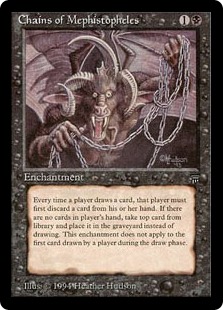 Finally, black discard may seem an unusual place for an enchantment, but I would draw your attention to this card. Chains of Mephistopheles is a very important historical card in both Type I and Vintage. Chains was a great example of black discard, and a powerful anti-blue tactic, especially in the Brainstorm era.
Finally, black discard may seem an unusual place for an enchantment, but I would draw your attention to this card. Chains of Mephistopheles is a very important historical card in both Type I and Vintage. Chains was a great example of black discard, and a powerful anti-blue tactic, especially in the Brainstorm era.
I mention all of this to say that black enchantments can naturally do anything black does well, except for tutor, although you can shoehorn tutors onto a black enchantment if you truly wanted.
YMTC 4 Design Ideas
I have discussed several broad approaches to designing cards for Vintage: improving upon existing cards, working backwards to reverse engineered tactically disruptive effects, creating situationally worse and better variants, using extreme conditionality to create efficient effects, and tapping into unusual alternative casting costs. The last three are design areas that I think are particularly well suited for Eternal because they create playables while expanding the relevant card pool.
Applying these design principles, I will now discuss some card design ideas for YMTC 4.
Leylines may not fit the mold for being “better or worse 50% of the time,” but they are a very effective way to create Eternal playables. Leylines have the benefit of being free and uncounterable. That makes them all serious considerations for Eternal. Leylines have proven to be highly playable in Eternal formats, with over half of the Leylines in existence having seen play in a Vintage Top 8 at some point.
In brainstorming enchantments for YMTC, the first area of inquiry was Leylines. In particular, I was talking with my friend and teammate Kevin Cron about the possibilities of taking old Type I enchantments and turning them into Leylines.
My first idea was Leyline of the Lich.
Leyline of the Lich
2BB
Enchantment
If Leyline of the Lich is in your opening hand, you may begin the game with it on the battlefield.
As Leyline of the Lich enters the battlefield, you lose life equal to your life total.
You don’t lose the game for having 0 or less life.
If you would gain life, draw that many cards instead.
Whenever you’re dealt damage, sacrifice that many nontoken permanents. If you can’t, you lose the game.
When Lich is put into a graveyard from the battlefield, you lose the game.
Lich is an old and fascinating card with an absurd drawback – that you lose the game if it is put into your graveyard. One of the primary combos with Lich is using Children of Korlis to draw a bunch of cards. If Lich were a Leyline, and put into play before the game begins, you would not be able to use Children to generate an Ad Nauseam like effect. Yet, you would begin the game with it in play, and so could immediately use life gain to draw cards.
While that is the upside, the downside is that your opponent could burn you before you have a turn, forcing you to sacrifice the Lich, and/or could simply destroy it with a Nature’s Claim, causing you to lose the game before you had a turn. That would make Leyline of the Lich balanced and interesting. It is sometimes better than Lich, and sometimes much worse.
While I am personally fascinated by that idea for YMTC, I did not think it was going to be a strong submission candidate.
The next idea that captured my imagination was Leyline of the Chains of Mephistopheles. Since that is one of Kevin Cron’s favorite cards, I tasked him with finding an elegant template. It is now his submission for the process:
Leyline of Mephistopheles
2BB
Enchantment
If Leyline of Mephistopheles is in your opening hand, you may begin the game with it on the battlefield.
If an effect would cause a player to draw a card, that player discards a card and draws a card instead.
This is the card I hope WotC selects, out of all of the cards I’ve seen, for a vote.
This card makes it extremely difficult for blue to generate card advantage, but not impossible. Dark Confidant still works, Necropotence still works, and son on. It’s just that cards like Gush, Brainstorm, Ponder, and Jace are severely punished.
I believe this card would be both Vintage and Legacy playable, and very good in Legacy in particular, by punishing and helping deal with Brainstorm and Ponder decks. It would be a very healthy card for that format.
Applying the first design approach I discussed, reverse engineering a card to tackle a popular tactic or strategy, Kevin came up with this card as a way to combat Lodestone Golem:
Anti-Shop Leyline 1
2BB
Enchantment
Each creature gets +X/-X, where X equals the number of artifacts its controller controls.
Anti-Shop Leyline 2:
2BB
Enchantment
Each creature gets +X/-X, where X equals the number of artifacts in its controller’s graveyard.
I like this card idea a lot, especially the second one. Black, with a very few exceptions, does not interface much with artifacts. This is a clever way to deal with Workshops without being overpowered.
I have scanned every black enchantment ever printed, and there are a number of recurring themes. First, a huge number of these enchantments have conditional triggers like sacrifice a creature, or when a creature comes into play (Carnival of Souls), or a specific kind of permanent comes into play.
I came up with a number of variants of a Leyline or otherwise a general enchantment that had a trigger that allowed you to do something black would do, like drawing a card, forcing the opponent to discard a card, destroy a nonland permanents, or forcing the opponent to sacrifice a non-land permanent.
Gravestorm and Carnival of Souls illustrates things that might cause a trigger, such as an upkeep or a particular kind of permanent coming into play. Other triggers could be opponents casting any spell, drawing or discarding a card, or putting a card in a graveyard. Ultimately, none of these things really interested me.
Applying the principle of using unusual zones for alternative costs, such as exiling cards from the library or the stack, here are two design ideas:
Strength in Death
2BB
Enchantment
1, Exile the top 2 cards of your library: draw a card.
An obvious Greed/Necropotence variant that imposes a hard limit on how many cards you can draw per game. Rather than taking up life, it takes up cards from your library. To draw 20 cards, you would have to exile 40 cards.
This is the card idea that I think is most interesting in this design space:
Leyline of Dark Matter
2BB
Enchantment
Whenever the opponent casts a spell, you may exile a spell you control (on the stack)*. If you do, add a Dark Matter counter to Leyline of Dark Matter.
0, Remove a Dark Matter counter from Leyline of Dark Matter: Target opponent discards a card. Activate this ability only any time you could cast a sorcery.
The idea behind this card is simple: it’s an anti-blue Leyline. If the opponent attempts to counter your spell, you can remove it from the stack, and force them to discard a card instead!
It may be possible to phrase this card without using the term the “stack” (please see my lengthy footnote on this issue at the end of this article).
Ultimately, what I kept being drawn to is a Nether Void variant that costs 2, and would be particularly good in Legacy. Without giving you every version, here’s what I settled on, and ultimately what I submitted for the YMTC design contest:
Lesser Void
BB
Enchantment
Whenever a player cast a spell with a converted mana cost 1 or less, counter it unless they pay 2.
The idea is simple: 0 casting costs spells, like Moxen, cost 2. 1 casting cost spells, like Brainstorm, cost 3. 2 casting cost spells aren’t affected. It does not affect Tarmogoyf, but hoses the Brainstorm/Ponder/Delver dynamic. Force of Will and Daze aren’t affected. Workshop decks aren’t affected much, and Dredge even less. It’s a powerful way to slow down early development in both Legacy and Vintage from the most explosive decks.
I costed it BB to prevent Workshop decks from using it off a rainbow land and a Mox. This card is far more clearly targeted at RUG and BUG decks in Legacy, without making it almost impossible to cast Tarmogoyf. This card is also ridiculously good in Vintage on the play the idea is that it could help revive Suicide Black type decks or Beats decks with Cavern of Souls (notice the interaction) in either Eternal format.
Conclusion
My favorite YMTC submission idea is Leyline of Mephistopheles. It makes it difficult to generate card advantage through blue draw spells, without making it impossible to generate card advantage through other means. My second favorite is Lesser Void, which I would love to see up for a vote.
Far more important than the particular YMTC ideas is my analysis regarding design approaches for Eternal. This article argues that deep space that exists for card design. I try to set out approaches that seem to have particularly productive possibilities for Eternal. In particular, I look at extreme conditionality, drawing upon unusual alternative casting costs and resources, and trying to design cards that are situationally better and worse than existing playables. I hope that you enjoyed this article, and continue to participate in the You Make the Card process. Let’s not be afraid to push for Eternal playables, and to recognize the deep design space that exists for developing them.
While designing for Eternal may carry risks, the benefits at least as great. Importantly, and this is worth reiterating, it is possible – very easy, in fact – to design Eternal playables that are not overpowered in other formats. I discussed many examples of cards like this, including Grafdigger’s Cage, and the like. As Mark Rosewater said many years ago: “With each new release, the power level of Type 1 goes up. This means that it becomes harder and harder to create a card that doesn’t unbalance Standard that can impact Type 1.” As I’ve tried to demonstrate, the idea that one cannot design Eternal cards for risk of endangering other formats is pure myth. Moreover – and this has not yet been touched on – the sheer range of delivery mechanisms for new card printings makes this issue even less of a concern. Flusterstorm, for example, is not only a fantastic Eternal card, but an example of an excellent delivery mechanism for printing new eternal playables without disturbing limited or other constructed environments. The multiplicity of delivery mechanisms for new cards should embolden and encourage designers to design for Eternal.
Until Next Time,
Stephen Menendian
Postscript
* You’ll notice that I have the phrase “on the stack” in quotations. That is because it is, apparently, R&D’s current design philosophy to avoid using the term “the stack” on card templates wherever possible. This is feasible because, by definition under the rules, spells only exist on the stack. Therefore, the term “spell” can be used as a substitute and implies a presence on the stack without ever having to use that term.
I have concerns about this practice, for several reasons. First, I believe that it unduly limits and constrains design space. Although Mark Rosewater has said that this space is not that “not much,” I believe it is a very rich area for Eternal design.
Consider this card:
Stacked Bolt
RR
Instant
As long as this spell is on the stack, players can’t cast blue spells or activate abilities from blue sources that aren’t mana abilities.
Stacked Bolt deals 3 damage to target creature or player.
This card plays off of the Split Second mechanic, but illustrates the ways in which that mechanic can be selectively modified to create interesting eternal playables.
Second, even if we credit Mark’s view that this design space is not that expansive, by avoiding the use of the term, we actually are constraining our own imaginations and creative possibilities embodied in the structure of the game. I believe that language and thought are interconnected. I believe the consequences are more profound and harder to see than we can know.
Third, I believe the costs of using the term are greatly overstated. While the term might be confusing to some players, I believe it actually clarifies to use it—it explains more carefully where a spell is. Relatedly, while it is understandable to be concerned about whether all players or most players understand the intricacies of the stack, I believe that enough players have a basic grasp of the stack sufficient that a general rule of not using the term is unnecessary.
Fourth, I think it may be the case that continuing to avoid using the term may actually hinder broader understanding and awareness of this zone. The stack is a very important zone of play that every player must use. It is through repetition that we come to understand basic terms in Magic. By not using that term, I believe that the current design philosophy actually undermines better understanding of the game and this zone.
Finally, on a basic level, there is a kind of absurdity to finding alternative language – even verbal gymnastics – to avoid using the term. In what other area of the game is so fundamental a term so cautiously avoided as to not confuse new players? One could avoid using the term “library,” but doing so is unnecessarily constraining from a design perspective.
In sum, I believe that using the term opens up new design possibilities for Eternal, however limited they may seem, and the costs of using the term are much less than we may presume.


